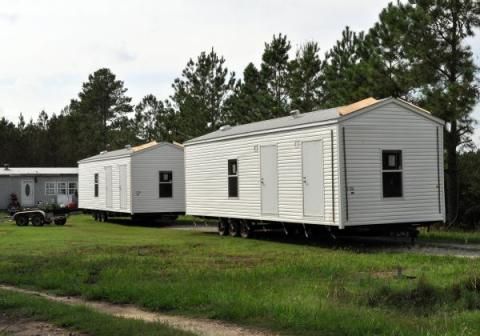
Photo of temporary housing units in North Carolina by FEMA.
The Federal Emergency Management Agency announced last week that they are delivering temporary housing units to Cobleskill, to be distributed to flood victims in New York State who cannot find available housing within their communities.
Those in need of housing should register with FEMA, and the agency will conduct a temporary housing needs assessment. If no rental units in the area are available, a temporary housing unit will be delivered and set up in a site approved by FEMA.
FEMA spokesperson Christopher Mckniff said that at least 50 temporary housing units were being deployed to Cobleskill. Mckniff said that the design of the temporary housing units had been updated since the Katrina disaster, when FEMA trailers became a ubiquitous sight throughout flood-ravaged New Orleans.
"It's not a trailer that you could hook onto a truck or a car and drive off. It's more of a prefab structure," said Mckniff. "It's a winterized, manufactured home."
There is no cost to rent a FEMA housing unit; however, all utilities will be paid by the occupant.
The full press release from FEMA and the New York State Office of Emergency Management:
ALBANY, N. Y. - The Federal Emergency Management Agency (FEMA) has initiated a program, in coordination with State and local governments, to provide Temporary Housing Units (THUs) to New York communities hard hit by Hurricane Irene.
"Temporary housing units are for people who need a place to stay, with utilities, while they repair their damaged homes," said Federal Coordinating Officer Philip E. Parr. "Our goal is to help people repair their homes as quickly as possible. The temporary housing units meet short-term housing needs, while flood survivors make repairs."
"We will work one-on-one with people to help them recover from this severe flooding," said Andrew X. Feeney, Director of the New York State Office of Emergency Management and State Coordinating Officer.
"I want to thank FEMA for working to get these temporary housing units in place," said Congressman Paul Tonko. "These units will assist those hardest hit by the flooding, making certain they have living arrangements while they move forward with assessing and repairing the damage to their homes."
Available rental units on the open market within a reasonable distance are the primary option for temporary housing. The FEMA temporary housing units are another option.
The temporary housing units will be shipped to a federal staging area in Cobleskill and then moved to a private home site or a commercial site.
FEMA housing experts will call people whose homes or rental units were destroyed or severely damaged in the flooding, and who have registered with FEMA, to assess their temporary housing needs on a case-by-case basis.
FEMA will discuss with flood survivors whether a temporary housing unit is the best option or if rental units are available within a reasonable distance. The site must be clear of debris and utility hook-ups must be readily available. A site inspector will look at the property to make sure it is suitable for a temporary housing unit.
After the site is approved, the temporary housing unit will be delivered and set up. Once the unit is ready, FEMA will schedule an occupancy date with the homeowner or renter.
FEMA does not charge rent for the temporary housing unit, however applicants must pay all utilities.
While living in the housing unit, residents can actively pursue making home repairs so they can return to their home as soon as possible.
To register with FEMA, call the FEMA Helpline at 800-621-3362. Phone lines are open from 7 a.m. to 10 p.m. ET, seven days a week until further notice. People with hearing disabilities can use the TTY number, 800-462-7585. Applicants can also register online at www.DisasterAssistance.gov or with any web-enabled mobile device or smartphone at m.fema.gov.











